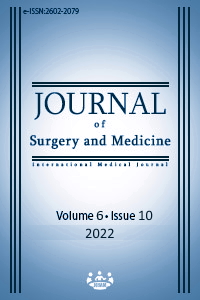Laparoscopic clips can be a safe buttressing method for the sleeve gastrectomy operations: An experimental study on resected sleeve gastrectomy specimens
Buttressing method for the sleeve gastrectomy
Keywords:
Obesity, Sleeve gastrectomy, LeakageAbstract
Background/Aim: Laparoscopic sleeve gastrectomy has been accepted in obesity surgery, as it provides rapid weight loss and has low mortality rates. However, because of the long staple line, leakage is a significant problem for these patients. Buttressing methods can be used to reduce the leakage. The aim of this study was to evaluate the efficacy of clips for buttressing the staple line on resected sleeve gastrectomy patients.
Methods: The study included 20 patients aged 18–60 years who underwent laparoscopic sleeve gastrectomy surgery in our clinic. Any patients with connective tissue disease or with the removed stomach tissue not intact were excluded from the study. The age, gender, height, weight, and additional disease data were recorded. A manual manometer and inflation mechanism was created, and when the pressure suddenly dropped and a bubble was observed from the staple line, this value was recorded as the leakage pressure. By measuring the leakage pressure in the staple line by inflating the resected and removed stomach, leakage pressure and leakage location were recorded as no-clip leakage pressure. Then, the observed area of leakage was buttressed with laparoscopic clips, and the leakage pressure was measured once more by inflating the stomach; this value was recorded as the clipped leakage pressure.
Results: The first pressure value observed had a mean of 43.8mmHg (range, 35–55 mmHg); after application of the clips, the mean was 43.8 mmHg (range (40–50 mmHg) (P = 0.20). The leakage was located in the upper section in 14 (70%) cases, in the mid-section in 5 (25%) cases, and in the lower section in 1 (5%) case. Micro-leakage was observed in 15 (75%) cases, 1-mm leakage in 1 (5%) case, 2-mm leakage in 2 (10%) cases, and 3-mm leakage in 2 (10%) cases.
Conclusion: Leakage is the most significant complication following sleeve gastrectomy surgery. The use of laparoscopic clips was described as a buttressing method, but no positive effect of metal clips on leakage pressure was observed in our study. Clarification of the effect of the buttressing with metallic clips is required using in vivo and ex vivo experiments.
Downloads
References
Marceau P, Biron S, Bourque RA, et al. Biliopancreatic diversion with a new type of gastrectomy. Obes Surg. 1993;3:29-35. DOI: https://doi.org/10.1381/096089293765559728
Sakran N, Goitein D, Raziel A, Keidar A, Beglaibter N, Grinbaum R, et al. Gastric leaks after sleeve gastrectomy: a multicenter experience with 2,834 patients. Surg Endosc. 2013 Jan;27:240-5. DOI: https://doi.org/10.1007/s00464-012-2426-x
Sajid MS, Khatri K, Singh K, Sayegh M. Use of staple-line reinforcement in laparoscopic gastric bypass surgery: a meta-analysis. Surg Endosc. 2011;25:2884-91. DOI: https://doi.org/10.1007/s00464-011-1637-x
Assalia A, Ueda K, Matteotti R, Cuenca-Abente F, Rogula T, Gagner M. Staple-line reinforcement with bovine pericardium in laparoscopic sleeve gastrectomy: experimental comparativestudy in pigs. Obes Surg. 2007;17:222-8. DOI: https://doi.org/10.1007/s11695-007-9033-2
Shah SS, Todkar JS, Shah PS. Buttressing the staple line: a randomized comparison between staple line reinforcement versus no reinforcementduring sleeve gastrectomy. Obes Surg. 2014 Dec;24:2014-20. DOI: https://doi.org/10.1007/s11695-014-1374-z
Faul F, Erdfelder E, Lang A-G, Buchner A. G*Power 3: A flexible statistical power analysis program for the social, behavioral, and biomedical sciences. Behavior Research Methods 2007;39:175-91. DOI: https://doi.org/10.3758/BF03193146
Tan JT, Kariyawasam S, Wijeratne T, Chandraratna HS. Diagnosis and management of gastric leaks after laparoscopic sleeve gastrectomy for morbid obesity. Obesity Surgery. 2010;20:403-09. DOI: https://doi.org/10.1007/s11695-009-0020-7
Sarkhosh K, Birch DW, Sharma A, Karmali S. Complications associated with laparoscopic sleeve gastrectomy for morbid obesity: a surgeon’s guide. Can J Surg. 2013;56:347-52. DOI: https://doi.org/10.1503/cjs.033511
López-Monclova J, Targarona E, Balague C, Vilallonga R, Rodríguez-Gómez K, Baeza-Vitolas M. Pilot study comparing the leak pressure of the sleeved stomach with and without reinforcement. Surg Endosc. 2013 Dec;27:4721-30. DOI: https://doi.org/10.1007/s00464-013-3123-0
Guerrier JB, Mehaffey JH, Schirmer BD, Hallowell PT. Reinforcement of the Staple Line during Gastric Sleeve: A Comparison of Buttressing or Oversewing, versus No Reinforcement- A Single-Institution Study. Am Surg. 2018 May 1;84(5):690-4. DOI: https://doi.org/10.1177/000313481808400521
Yavuz A, Buluş H. The Effect of Reinforcement Methods with Knotted and Knotless Sutures: Comparison of Burst Pressures. J Laparoendosc Adv Surg Tech. 2017;27:629-32. DOI: https://doi.org/10.1089/lap.2016.0074
Yiğit VM, Bahçe ZŞ. The effects of using metal clips to support the stapler line lengthwise on bleeding and leakage in laparoscopic sleeve gastrectomy. Laparosc Endosc Surg Sci. 2022;29(1):18-22. doi: 10.14744/less.2022.67689. DOI: https://doi.org/10.14744/less.2022.67689
Downloads
- 321 529
Published
Issue
Section
How to Cite
License
Copyright (c) 2022 Abdulkadir Ünsal , Alper Yavuz, Altan Aydın; Hakan Buluş
This work is licensed under a Creative Commons Attribution-NonCommercial-NoDerivatives 4.0 International License.
















